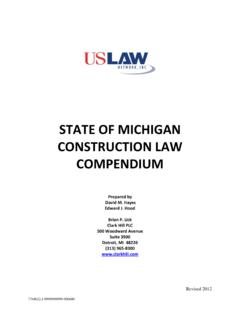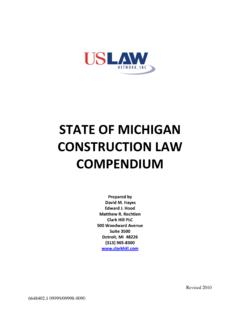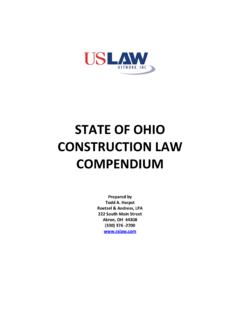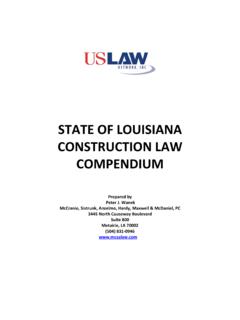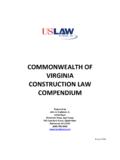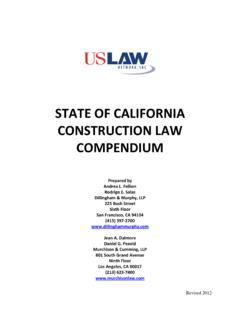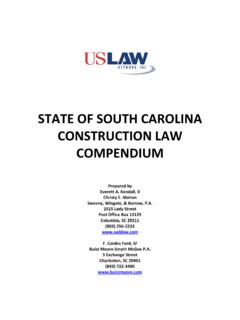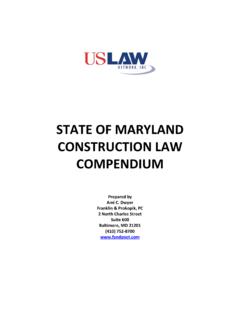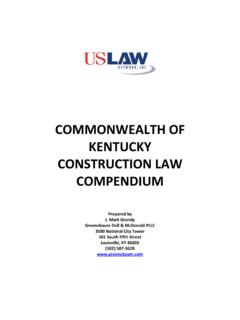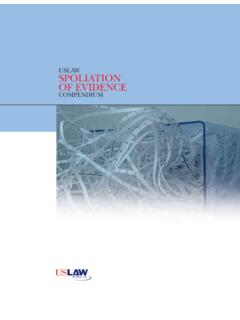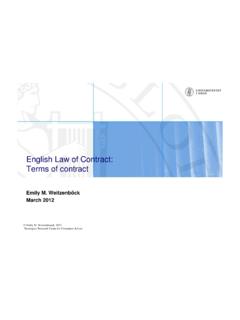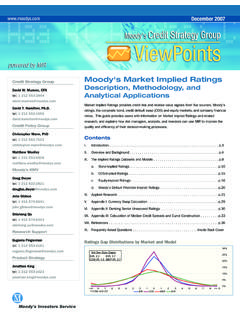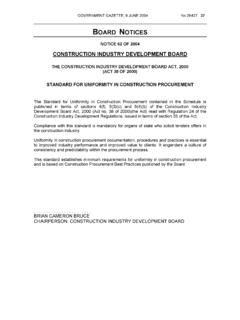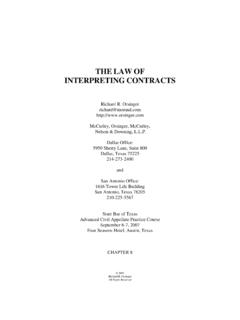Transcription of STATE OF KANSAS CONSTRUCTION LAW COMPENDIUM
1 Revised 2012 STATE OF KANSAS CONSTRUCTION LAW COMPENDIUM Prepared by Kenneth E. Holm Theresa A. Otto John J. Gates Baty, Holm, Numrich & Otto, 4600 Madison Avenue, Suite 210 KANSAS City, MO 64112 (816) 531 7200 2 Revised 2012 This outline is intended to provide a general overview of KANSAS CONSTRUCTION Law. While the authors have described several topics below, the discussion of any particular topic is not intended to be a total analysis of the area. I. ACTIONABLE CLAIMS IN CONSTRUCTION DEFECT LITIGATION A. Breach of Contract KANSAS recognizes a cause of action in the CONSTRUCTION context for breach of contract claims, but one who claims damages on account of breach of contract must show not only the injury sustained, but also, with reasonable certainty, the amount of damages suffered as a result of the injury or breach.
2 In order for the evidence to be sufficient to warrant a damages award, there must be some reasonable basis for omputation that will enable the jury to arrive at an approximate estimate thereof. STATE of KANSAS ex rel. v. Carla Stovall, 278 Kan. 3, 91 531 (2004). Damages recoverable under breach of contract are limited to those damages that may fairly be considered as arising in the usual course of things from the breach, or as may reasonably be assumed to have been within the contemplation of both parties as the probable result of the breach. Damages which are not a result of the breach, but rather remote, cannot serve to support a judgment. KANSAS STATE Bank v. Overseas Motosport, Inc., 222 Kan. 26, 563 414 (1977). Loss of profits resulting from a breach of contract may be recoverable as damages when such profits are proved with reasonable certainty and may reasonably be considered to have been contemplated by the parties.
3 Vickers v. Wichita STATE University, 213 Kan. 614, 518 512 (1974); Zenda Grain & Supply Co. v. Farmland Industries, Inc., 20 728, 894 881 (1995). See also MLK, Inc., v. University of KANSAS , 940 1158, 23 876 2006). A contracting party whose performance is prevented by an adverse party is not obligated to perform; prevention is itself a breach of contract, making the preventing party liable for damages for the breach, and excusing the other party from completion of his performance. Briney v. Toews, 150 Kan. 489, 95 355 (1939). In Ford Motor Credit Co. v. Suburban Ford, 237 Kan. 195, 699 992 (1985), the KANSAS Supreme Court held that tort claims could not be maintained between parties in a contractual relationship to impose tort duties concerning matters that the parties had allocated themselves by contract.
4 When the elements of both tort and breach of contract are present, the key difference is whether the contract calls for specific results. When the contract does not call for the specific result at issue, the action is more in the nature of violation of the duty imposed by law instead of failure to perform a duty arising by reason of agreement. In such a case, plaintiff s complaint is not that the defendant failed to perform the contract, but that the defendant failed to perform it with due care. Hunt v. KMG Main Herdman, 17 418, 839 45 (1992). KANSAS courts have held that comparative or contributory negligence principles do not apply to breach of contract cases where a plaintiff has requested only economic damages as a remedy.
5 Foodbrands Supply Chain Services, Inc. v. Terracon, 3 Revised 2012 Inc., 2003 WL 23484633 (D. Kan. 2003); Haysville No. 261 v. Gaf Corp., et al., 233 Kan. 635, 666 192 (1983). Liquidating agreements designed to overcome legal impediments due to privity of contract and allow contractors to bring an action against the owner on behalf of their subcontractors have three basic elements: (1) the imposition of liability upon the general contractor for the subcontractor s increased costs, thereby providing the general contractor with a basis for legal action against the owner; (2) a liquidation of liability in the amount of the general contractor s recovery against the owner; and (3) a provision that provides for the pass-through of that recovery to the subcontractor.
6 Roof-Techs International, Inc. v. The STATE of KANSAS , 30 1184, 57 538 (2002). KANSAS courts have routinely found contracts enforceable even though one or more terms were left open at the time the contract was formed. 84-2-204. In Christopher & Son v. KANSAS Paint & Color Co., 215 Kan. 185, 523 709, the court considered whether the parties entered into a binding and enforceable oral contract. In that case, the defendant questioned the existence of a contract at the time its bid was accepted, arguing that an oral contract regarding a sale of paint was unenforceable because at the time it was made many essential matters were not covered. The court recognized any contractual relationship was necessarily based on the specifications for the paint and the bid.
7 The court laid out the pertinent statutory section, 84-2-204(3) as set forth above, and stated: [T]hose drafting the statute intended that the omission of even an important term does not prevent the finding under the statute that the parties intended to make a contract. 215 Kan. at 193, 523 709 (quoting Southwest Engineering Co., Inc. v. Martin Tractor Co., Inc., 205 Kan. 684, 692, 473 18 [1970]). B. Negligence Negligence actions remain viable remedies for CONSTRUCTION defect claims where there is no contractual privity. Kristek v. Katron, 7 495, 644 480 (1982). A purchaser may recover property damage caused by a leak from an improperly constructed roof against a builder in negligence in the absence of contractual privities.
8 A claim may not be available in circumstances in which the matter is covered by contract. A general contractor may be liable for a failure to keep premises in a safe condition even though the general contractor had turned his keys over to a third party because the contractor had returned to the building and instructed workers to prevent access to dangerous areas. Miller v. Zep Mfg. Co., 249 Kan. 34, 815 506 (1991). But the owner of a CONSTRUCTION company, who looked at the church s structural damage at the church s request and pointed out his recommendations to an engineer, could not be liable for his failure to warn the neighbors of the church who were killed when the church collapsed on their residence. Gooch v. Church, 246 Kan.
9 663, 792 993 (1990). Such contractor did not assume the duty owed by church to warn the neighbors because his inspection was conducted for his own benefit in determining whether to bid on repair job. However, negligence claims carry with them the application of comparative fault, which may provide a defense or at least a mechanism for reduction of exposure to the party against whom it is brought. 60-258a. The concept of comparative negligence/fault in KANSAS as applied to all causes of action is based on the less than or 49% rule. The injured or damaged party may recover only when his fault is less than the fault of the parties against whom claim for recovery was made. If the 4 Revised 2012 plaintiff and the defendant(s) are equally at fault, there can be no recovery.
10 60-258a. The KANSAS Comparative Negligence Act abolished joint and several liability, contribution among tortfeasors, and active/passive negligence, but permits modified implied comparative indemnity where a tortfeasor settles with the plaintiff for the full amount and proceeds after the other tortfeasors in the chain of distribution in product liability cases or contracting parties in CONSTRUCTION defect cases. The Act did not abolish the defense of mitigation of damages and the defense of assumption of risk in a very restricted periphery. Jackson v. City of KANSAS City, KANSAS , 235 Kan. 278, 680 877 (1984). Tort claims, such as negligence and implied warranty in tort, are subject to the Economic Loss Rule where there is no personal injury or fiscal damage to property.
